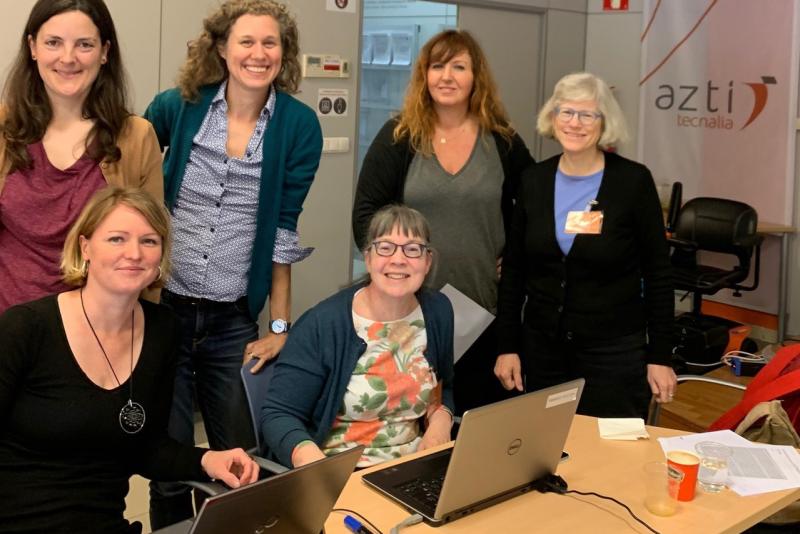Can you tell us about your science journey, your career in science?
I started my undergraduate work at the University of Notre Dame as a chemical engineer, but switched to sociocultural anthropology after an introduction to Anthropology course. I later took a linguistic anthropology class. At the time I spoke English, French, and Spanish fluently and found the differences in the languages and the cultures they were embedded in fascinating. Between my love of language and the linguistics class, I knew what my focus would be in graduate school. I took a year off after graduation to join my family in Venezuela. My Dad taught math at the Universidad de Oriente in eastern Venezuela. He asked about jobs for me and a student knew someone at Corporiente—a regional development organization affiliated with the Venezuelan government. They hired me to do small ethnographic studies of a local farming community and a local fishing community. I became interested in Venezuelan government-sponsored fishing cooperatives and realized that this was the direction I wanted my career to go.
I applied to Indiana University and did my Ph.D. research in Venezuela. It focused on two neighboring fishing communities. Each had a government-funded cooperative implemented to increase fish production while improving living conditions for local fishermen. One cooperative succeeded, the other didn’t. Fishing cooperatives tend to fail, largely because fishermen are so independent. Here the communities and fisheries were similar. So why different outcomes? The key was that in one town the cooperative manager was the son of a beloved local school teacher. It was a purely social factor, unrelated to the cooperative.
Near the end of graduate school, I attended a meeting of what is now called the International Association for the Study of the Commons. There I met Dr. Peter Fricke, then a sociologist in NOAA’s Office of Sustainable Fisheries in Silver Spring, Maryland. He told me the Northeast Fisheries Science Center was looking to hire an anthropologist—the first ever in a region! I applied, did a phone interview, and got the job.
Could you share an example of a hurdle or obstacle you experienced during your science journey? How did you overcome it?
I have had a number of challenges during my career. During my job interview I asked about funding for fieldwork. There was a pause, and then “Oh, yeah, you guys do that. I can offer you a government vehicle and anything from the supply closet.” When I arrived, some of my colleagues felt anthropology was not a “real” science. They thought that anthropology merely consisted of “collecting anecdotes.” That, along with being young and a woman, meant I occasionally ran into people who weren’t sure I was a useful addition to the science team. An older male scientist gave me unsolicited “advice from Uncle [name].” A fisheries council staffer exclaimed, “What’s next? Their shoe size?” after I explained the type of social and cultural data I’d been collecting. But nevertheless I persisted. I had a lot of help and support from the science center’s Economics Investigation, now called the Social Sciences Branch. Many other center staff—male and female—also helped and supported me, including Alan Peterson, who was then the center Director.
Today there are social scientists in the science center and at the councils. In those early years, I took my work seriously. I used available data in existing databases, coordinated a meeting of regional social scientists, and began producing Social Impact Assessments. I showed that I was determined and knowledgeable.That paved the way for more anthropologists in the Northeast and other NOAA Fisheries regions throughout the United States.
Burnout happens in the sciences. How have you and/or your employer, supervisor, or organization helped to prevent it?
I have been very lucky when it comes to burnout. Because there had never been an anthropologist in a field office, I was able to design my own position description. Being the first has also meant there was no lack of interesting research to get involved in—sometimes too much. I have tended to automatically say yes and only in more recent years learned to sometimes say no. So I am, in theory, not snowed under by too much work. I have been able to set agendas for research and have input into regional and national policy documents.
The science center and my branch were supportive when I had my children. I was able to take 6 months off after each child was born, and then work part-time while they were small. That made all the difference in the world when it came to my overall job and life satisfaction. I’ve also had health issues and leave related to two brain surgeries. I’m lucky because I knew my job would still be there when I was able to return. Since my surgeries, it’s more difficult to travel. But if you ask for help, people will step up. I am an active and respected member of the Social Sciences Branch and the broader fisheries anthropology profession.
What are some new exciting areas in your field or research that you think the next generation of women scientists should pay attention to?
One of the most exciting is the turn to multidisciplinary teams working on the science to support ecosystem-based fisheries management. NOAA is doing this through its Integrated Ecosystem Assessment (IEA) teams. These IEAs are also being used in Europe by the International Council for the Exploration of the Sea (ICES)—a sort of NOAA Fisheries for Europe. Along with other social and natural scientists from the science center, I belong to both NOAA IEA teams and ICES Working Groups.
NOAA Fisheries has been a leader in developing fisheries-related social indicators. We look at factors like population, poverty, crime, and housing characteristics from the U.S. Census, and fish landings from NOAA. These indicators are being improved and newly developed at the community level.
NOAA Fisheries is also developing fisheries-related cultural indicators. Right now cultural indicators are perhaps best developed as qualitative indicators. However, collecting qualitative data can be expensive, and integrating it with quantitative data can be difficult. In the social sciences, we are struggling with these and related issues.
In the Northeast, we also have some NOAA Fisheries climate-related community indicators. They look at, for example, changes in levels of climate-vulnerable species landed over time, and sea level rise. We need to better understand how individuals and communities react and adapt to climate-induced changes in fisheries. And we also want to know why certain individuals or communities make specific choices.
There are more exciting areas of research, but I won’t list them all. One of the things I love about being an anthropologist is that our topic of study is humans. We can study anything people do or think or believe. There are always new and interesting topics to study because people are endlessly inventive.
What advice do you have for the next generation of women scientists about a science career?
Study what interests you, though that may change several times from high school through college and potentially graduate school. Take statistics—even if you don’t think you’ll need it—because you will. Don’t be afraid to change direction mid-stream if you discover something new that really excites you. Seek out mentors; women, but also others. Find ways to publish, even if you are one of multiple authors. It helps in job searches, but more importantly, it helps you hone your research and writing skills. You can do amazing research, but if you don’t write it up and publish it—alone or as part of a large team—those results will not advance the state of the science. In the end that is what we are trying to do as scientists, help to fill in gaps in the overall understanding of how the world works.
As you become more established, it helps to pause before you say yes to a new project, journal article review, or advisory board position. Sometimes I just feel overwhelmed by all the deadlines. Learn to prioritize and keep saying no until you can see daylight at the top of the hole you dug yourself into. Ultimately, though, the enjoyment and excitement of the research keeps you going.
For more information, please contact Heather Soulen.




